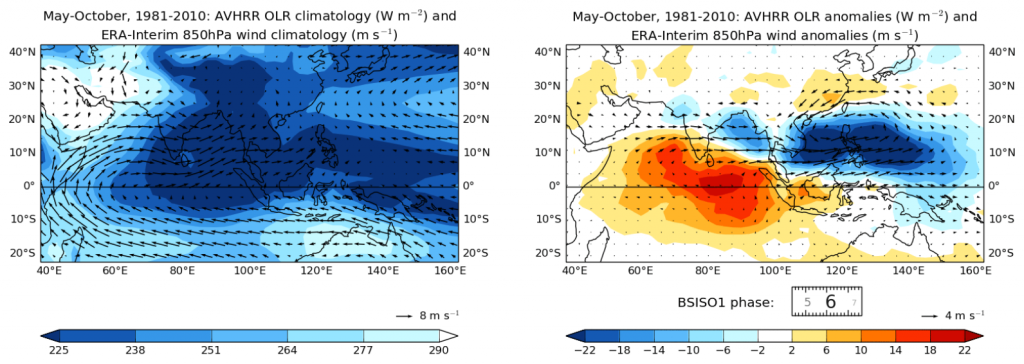The Indian Summer Monsoon (ISM) is one of the most significant features of the tropical climate. The heavy rain it brings during boreal summer provides around 80% of the annual precipitation over much of India with over 1 billion people feeling the impact, especially through the effect on agriculture. The typical impression of the monsoon which many members of the public have is of constant, torrential rain during the summer months as though a tap is turned on sometime in June, eventually petering out at the end of the season. The reality, however, is an active/break cycle on intraseasonal timescales.
The chief source of intraseasonal variability in the ISM region during boreal summer is the BSISO (Boreal Summer IntraSeasonal Oscillation). Similar to the famous real-time multivariate MJO (RMM) indices of Wheeler and Hendon (2004), which divide the Madden-Julian Oscillation into eight phases, the BSISO indices were developed by Lee et al (2013) based on multivariate EOF analysis of outgoing longwave radiation (OLR) and 850 hPa zonal wind. Two cycles were identified (BSISO1 and BSISO2); here we consider the former. BSISO1 is found to have a period of 30–60 days; a composite life cycle of OLR and 850 hPa wind anomalies is shown in Figure 1b in which a nominal period of 48 days has been chosen, with each frame of the animation corresponding to one day. The boreal summer climatology is shown for reference in Figure 1a. Alternate active and suppressed regions of convection begin over the equatorial region of the Indian Ocean, propagating northwards over the Arabian Sea (west of India), India, the Bay of Bengal (BoB; east of India) and south-east Asia. The MJO chiefly consists of slow eastward propagation of large-scale organized convective envelopes from the Indian Ocean, through the Maritime Continent, to the tropical Pacific. The BSISO may be thought of as the MJO’s northward branch, unique to the boreal summer months.
Figure 1: Boreal summer (May to October) OLR from AVHRR and 850 hPa wind from ERA-Interim (1981-2010): (a) climatology; (b) anomaly for each day of a nominal 48-day BSISO1 life cycle, computed by linearly interpolating between composites of the eight phases. (After Adrian Matthews’ MJO diagrams.)
The monsoon onset, withdrawal and active/break events are generally poorly forecast. This is partly due to a poor understanding of the physical mechanisms behind them. One major gap in our knowledge is the effect of air-sea interactions in the BoB. The Bay of Bengal Boundary Layer Experiment (BoBBLE) seeks to improve our understanding of these interactions and their effect on ISM variability. The BoBBLE field campaign took place in June–July 2016 and performed intensive observations in the BoB of atmospheric conditions, air-sea fluxes, and ocean currents and stratification.
In particular, the campaign saw the deployment of Argo floats (which remained in place after the campaign as part of the global Argo network) and seagliders [follow the link and select Mission 31]. These can be seen in this video clip showing the route of the research vessel Sindhu Sidhana (Figure 2).
The BoBBLE field campaign took place in June–July 2016 and performed intensive observations in the BoB of atmospheric conditions, air-sea fluxes, and ocean currents and stratification. In particular, the campaign saw the deployment of Argo floats (which remained in place after the campaign as part of the global Argo network) and seagliders (follow the link and select Mission 31) and the research vessel Sindhu Sidhana.
As part of the BoBBLE project, at Reading we are using data from the field campaign as part of a range of hindcast modelling experiments.

Figure 2: Research Vessel Sindhu Sidhana.
References
Lee, J.-Y., B. Wang, M. C. Wheeler, X. Fu, D. E. Waliser, and I.-S. Kang, 2013. Real-Time Multivariate Indices for the Boreal Summer Intraseasonal Oscillation over the Asian Summer Monsoon Region. Clim. Dyn., 40, 493–509.
Wheeler, M. C., and H. H. Hendon, 2004. An All-Season Real-Time Multivariate MJO Index: Development of an Index for Monitoring and Prediction, Mon. Weather Rev., 132, 1917–1932.
